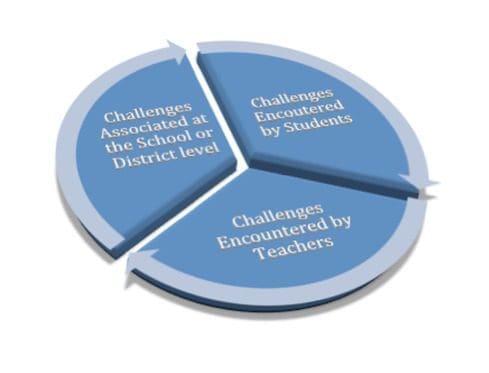
Using Community Challenges to Collecting Real-World Problems

Using Community Challenges to promote mind and skill sets is to collect real-world problems that are a challenge or driving question for students. This is PBL’s first step in the learning process, which is a challenge or driving question. It involves a project that matters in the real-world. Cathleen Beachboard, author of Using Community Challenges for Learning, gives tips on how to collect real-world problems for students. Beachboard gives this scenario:
“One day, I received an email from the assistant superintendent saying that the proposed school budget was in danger of being rejected, and he needed someone to advocate for student funding and security improvements. My eyes fell on the empty desks in front of me. What if I gave this local problem to my students? Using persuasive language to encourage others to adopt a budget falls squarely within my academic curriculum. By tackling this challenge, students might use content to impact the world around them. The students created a public service announcement and spoke at the county budget hearing. Months later, the budget passed, and for the first time in years, it was almost fully funded.”
The budget project was the beginning of the Community Problem Bank.
Have your students ever asked these questions?
“Why should I learn this?” “When am I ever going to use it?” “How is this information important for my life?”
Beachboard students have asked these questions year after year in her classroom. Beachboard’s conclusion is “They have longed to see how our content connects to the world.”
Community Problem Bank
The purpose is to help students address community challenges by using content that merges the best aspects of service learning, project-based learning, and growth mindset. Beachboard’s reason is that “every problem in life requires different tools to solve, the process is useful for all disciplines.”
Beachboard suggests these steps in collecting possible problems:
- Determine which real-world challenges are suitable for a bank
- Collect problems for the bank by scanning local news and reaching out to local government agencies, nonprofits, and other local businesses
- Reach out in person and give the community organization background information on my class and time frames for our projects.
- Ask only one question: What problems do you see in the local community or in your specific organization?
- When there are a few dozen problems, introduce students to the list
- Students are free to give input or add problems they feel are missing.
Organize the Problem Bank
Here are steps on organizing the problem bank suggested by Beachboard:
- Enter all the problems into the first column of a spreadsheet.
- Putting newer problems at the top allows students to quickly see new additions. You can curate a list that fits your grade level and students.
- Next three columns are labeled “Standards/Initiatives,” “Explore,” and “Coaching/Resources to Help”.
- The Standards/Initiatives column is a space to add in the specific class content or school initiatives that will benefit the learner while solving the problem.
- Explore column, add the names of students working on each project, as well as a link to their project planning sheet
- As work progresses, students and teachers add important information, questions, resources, and failures in the Coaching/Resources to Help column.
- To pair problems with standards, determine which curricular knowledge or skills your students may need to tackle each challenge.
Using the List
How to use the list:
- Use the problems bank to teach a concept to the entire class or
- Allow students to form groups and select their own standard-aligned problems to try to solve during or after a unit of study.
- Give students structure when they tackle big problems. A project planning sheet will guide students through the design thinking process to generate solutions.
- Hold three-to-four-minute project check-ins during which students share updates, and give coaching, guidance, and feedback. Do this once weekly.
- Check-ins are a great time to do mini lessons and look for indications of content mastery or needs.
- Students also reflect weekly on their progress toward solving or “moving” the problem, as well as the associated standards.
- These reflections provide formative insight and allow me to create whole-group lesson plans, as well as individual action plans, to help students master content.
BeachBoard Reflection
Beachboard describes her thoughts on taking on a real-world problem:
“Taking on real-world problems comes with the risk of failure. There is no answer key to the problems in the bank, so students have to learn and be coached through failure. A group of students in my class wanted to address Alzheimer’s disease. The standard paired with the problem was developing interview skills. They talked to family members, researched the disease, and learned about effects from a local care home. They had mastered the standards associated with interviewing for my content, but they were unable to come up with a solution for the disease.”
How Beachboard coached students in her own words:
“I coached them and pushed them to look for a new solution. It took them a few days, but they decided to stop focusing on the disease and to find a way to help the families of people with Alzheimer’s. They recorded the memories of Alzheimer’s patients at a local facility, and gave the recorded memories to the patients’ families. The students were upset because they hadn’t solved the big issue, but they didn’t let failure stop them from reframing the problem and finding a solution. Along the way, they learned perseverance, determination, and compassion for others.”
Beachboard Final Thoughts:
“Over the years, my students have failed and succeeded in solving community problems. No matter whether they succeed or fail, each class walks away with a new respect for learning. “This class has taught me that the more we learn, the more prepared we are to tackle the problems around us,” a former student said. “We may not solve all the problems today, but one day with more knowledge and skills we might.”
My Takeaway
I thought Beachboard using school budget cuts as a challenge or driving question for Project-Based Learning for students was a brilliant idea. I love the steps Beachboard has taken to give educators the opportunity to collect their own community challenge. This way, educators who are willing to go beyond for students to experience critical thinking skills and solve problems has my vote.
